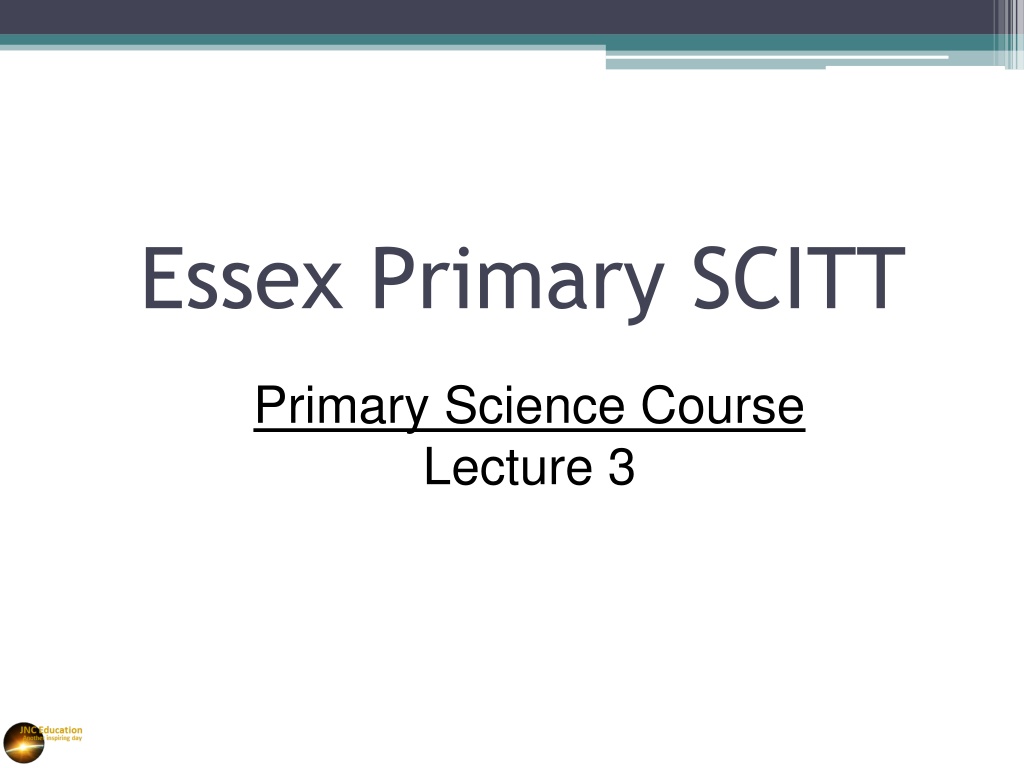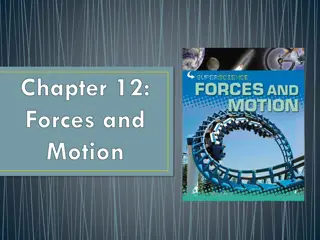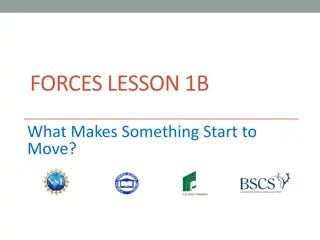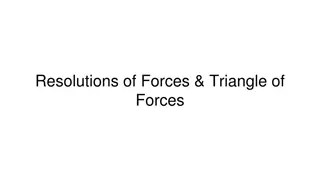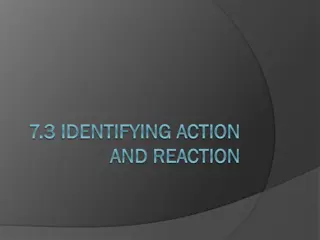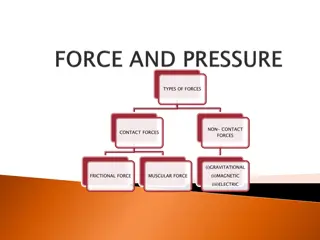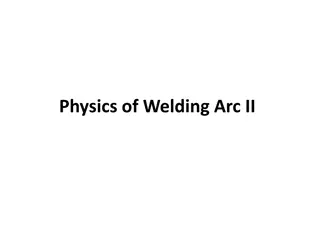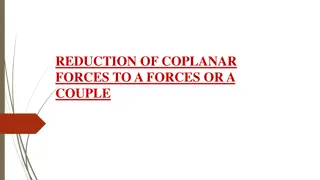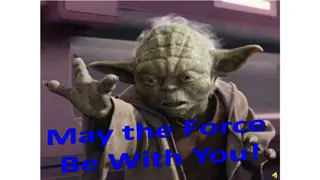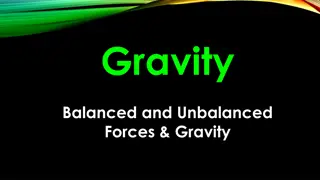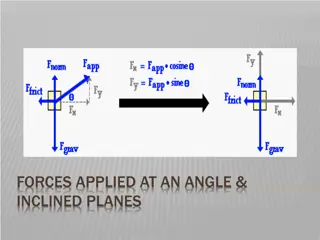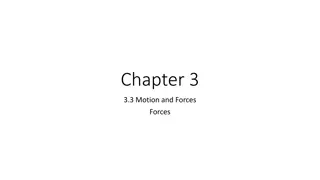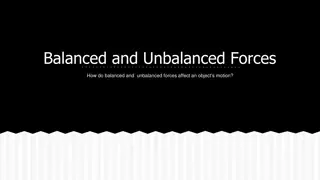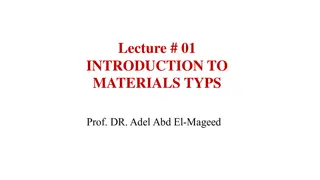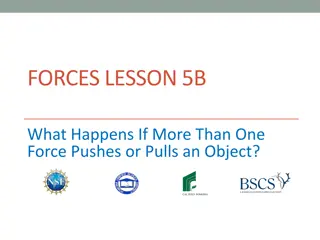Exploring Primary Science Concepts: Forces and Materials
Delve into the world of primary science with a focus on understanding materials and forces. Topics covered include properties of materials, states of matter, scientific inquiry skills, and a constructivist view of learning based on Piaget and Vygotsky's theories. The course aims to develop trainees' knowledge through practical activities and effective lesson planning strategies.
Download Presentation

Please find below an Image/Link to download the presentation.
The content on the website is provided AS IS for your information and personal use only. It may not be sold, licensed, or shared on other websites without obtaining consent from the author. Download presentation by click this link. If you encounter any issues during the download, it is possible that the publisher has removed the file from their server.
E N D
Presentation Transcript
Essex Primary SCITT Primary Science Course Lecture 3
2 Review of last time To develop trainees knowledge and understanding about materials, including: materials and their properties; solids, liquids, gases; particle theory; effect of heating and cooling; change of state; dissolving. To develop trainees knowledge and understanding of the process skills of observing and questioning. To learn how to plan an individual/paired practical science activity, including how to organise the classroom so that this can be done safely.
Feedback from last time I would have liked the lecture to be completed by looking at each slide. Paper plates under candles to catch melting wax to save the tables. Lines next to the slides to add notes. More on KS1. More time on strategies for learning. Chatting people a distraction. And one you will all get used to as teachers The pace was much better Some aspects could be pacier
Objectives for the day Develop trainees knowledge and understanding of the concept of forces, including: o Magnetic o Friction, including air resistance o Gravitational Consider elements of an effective science lesson plan. Develop trainees knowledge and understanding of the scientific enquiry skills of fair testing and recording, including the use of tables. Watch a science lesson and evaluate its effectiveness.
What have we learnt so far?
6 A constructivist view of learning Based on the work of Piaget (maturation) and Vygotsky (zone of proximal development) A child s head is not empty There is an interaction between pre-existing ideas and new experiences and phenomena Children attempt to make sense of new experiences and phenomena by constructing meaning This is a continuous and active process To learn, therefore, children not only have to assimilate new concepts but also develop, modify and change existing ones
What is a force? Give as many real world uses of the word Force as you can think of.
What do children think the word force means? My mother forces me to tidy the room when I don t want to. A force is when you are made to do something. Forces are big and strong. Forces are power and energy. When it snows and it s cold and there s snow everywhere you have to force your way through. I m not sure what force means but there s an air force. It s got a blue uniform. There s also brute force. Force is gravity and wind.
True or False? The weight of an object depends on how much stuff it is made from. A stiletto heel will make a deeper hole in a wooden floor than a wider heel, when worn by the same person. Crumpled paper falls faster because it weighs more than uncrumpled paper. When you stretch a spring down and let go, gravity makes it pull back up. Magnets will pull together or push apart depending on which way round the poles are.
We weigh less on the moon than we would on earth. A shark has a streamlined shape in order to reduce air resistance. Friction can be both helpful and unhelpful. A knot of plastic string is easier to untie than natural string because the plastic has a smooth surface so there is less friction. Unequal forces can change the shape, speed and/or direction of an object. A still object no longer has any forces working on it. To calculate the speed of an object you also need to know how long it has taken to do a journey and how heavy it is.
What do forces do? Make stationary objects move. Make moving objects speed up. Make moving objects slow down. Make moving objects stop. Make moving objects change direction. Change the shape of objects.
Two characteristics of forces Forces can be thought of as pushes and pulls. Pushes and pulls can create change: in the size of an object and/or the direction of movement. Whenever there is any change to the speed, direction of movement or shape of an object it is because forces are acting on it.
Magnets and Magnetism What do I know about magnets and magnetism?
NC Forces and Magnets LKS2 Year 3 compare how things move on different surfaces notice that some forces need contact between two objects, but magnetic forces can act at a distance observe how magnets attract or repel each other and attract some materials and not others compare and group together a variety of everyday materials on the basis of whether they are attracted to a magnet, and identify some magnetic materials describe magnets as having two poles predict whether two magnets will attract or repel each other, depending on which poles are facing.
Magnets Have 2 ends called poles, N and S. Opposite poles attract, like poles repel. Allowed to hang freely the N pole faces north. A permanent magnet is a piece of metal that has been magnetized. Only a few metals can be strongly magnetized and only some of these stay magnetised for any time. Most permanent magnets are made of iron, often combined with nickel and cobalt.
Magnetism Caused by the behaviour of electrons that remain in orbit in their atoms. They spin in a certain direction causing a magnetic force. If most of the atoms in a piece of metal are aligned so that the spins are in the same direction it is said to be magnetized. This can be induced by stroking a piece of iron with a magnet, in one direction.
Magnetic Poles The earth is a very weak magnet and has a magnetic field. A compass points towards magnetic north so that we can find our direction. Magnetic north is not at the North pole but at a point in northern Canada.
Magnets & Magnetism Activities What is a real life context to set the work in? EYFS Find 5 things that are magnetic/non-magnetic. What do you notice? KS1 Sort and classify materials Investigate/explore Are all metals magnetic? KS2 Describe some uses of magnets. Investigate - Are round magnets stronger than bar magnets? Find 3 ways to test the strength of magnets. Is it true the bigger the magnet the stronger it is?
Childrens questions Children play with magnets. They ask Where do you get magnets? Is the big one strongest? Why is the red end better than the blue? Where can you get magnets? Are horseshoe or bar magnets the best? Which of these questions could lead to scientific activity?
Questioning Progression Early stages Asking a variety of questions investigable and non- investigable. Discussing how to answer questions and which ones they can investigate themselves. Later stages Discussing how different kinds of questions can be answered. Recognising a difference between investigable questions and those that cannot be answered by scientific enquiry. Clarifying questions by identifying what to change and what to observe or measure.
22 National Curriculum - Forces Year 3 - Statutory requirements Pupils should be taught to: compare how things move on different surfaces Year 5 - Statutory requirements Pupils should be taught to: explain that unsupported objects fall towards the Earth because of the force of gravity acting between the Earth and the falling object identify the effects of air resistance, water resistance and friction, that act between moving surfaces recognise that some mechanisms, including levers, pulleys and gears, allow a smaller force to have a greater effect.
Measuring forces Mass (what is often called weight) is measured in grams and kilograms. Forces are measured in Newtons. On Earth gravity will pull on a 1Kg bag of sugar with a force of approximately 10 Newtons. The weight of any object is the amount of pulling force that the Earth exerts on that object.
Teaching children how to use a force-meter Remind children that forces are pushes and pulls. Ask them to turn to a partner, grasp each other by the and give a big pull. Next link little fingers and give a little pull. Ask them to name units of measure e.g. cms, seconds, Kgms. Tell them that we use Newtons to measure the force of pushes and pulls. Give out force meters. Allow children to try them out on objects in the class. Remind them to look at the scale. Then ask children to give a small pull on the force-meter of 2 Newtons or a larger pull of 10 Newtons. Now use the force meters to move an object predict first how much force will be required.
Mass, weight, force. A bag of sugar has a mass of 1 Kg. That is the amount of material (matter) it contains. In space it would be weightless , on Earth it would be pulled downwards by gravity with a force of about 10 Newtons. The mass is constant so if somebody threw the bag of sugar across the spacecraft and it hit you on the head, it would hurt as much as if it were thrown at you on Earth!
Newton meters weighing sugar On Earth. 1 Kg pulls with a force of 10 N. In space. 1 Kg pulls with a force of 0 N. 0 1 2 3 4 5 6 7 8 9 10 0 1 2 3 4 5 6 7 8 9 10 1 Kg 1 Kg
Types of forces Friction, including air resistance Gravitational Magnetic Electrical
Underlying principles of friction The direction of friction is opposite that of movement or potential movement. Friction can occur in the absence of movement e.g. a car parked on a hill. Both surfaces in contact contribute to the magnitude of the frictional force. Different surfaces oppose movement to different extents. Generally, the rougher the surface the greater the frictional force. Friction tends to be used for solids. Viscosity is used for liquids. Air resistance is used for gases.
Investigating shoe grip Carry out an investigation following these steps. Ask a question e.g. What type of shoe grip makes the safest shoe? Predict or hypothesise to consider what might happen. Model the activity if necessary. Scaffold thinking about ideas if necessary Convert un-useful ideas into meaningful ones Write ideas on yellow post-its and decide what to change. Write what to measure on a green post-it. Test and record results in a table. Draw a graph and form conclusions.
Prediction or Hypothesis? Prediction This is a statement about what may happen in the future based on previous knowledge. It is not a guess! A bridge made of 1 piece of card holds 100g. A bridge made of 3 pieces of card holds 300g. Prediction a bridge made of 2 pieces of card holds 200g.
Hypothesis or Prediction? Hypothesis This is a statement put forward to attempt to explain something. The suggested explanation need not be correct, but it should be reasonable in terms of the evidence available and possible in terms of scientific concepts or principles. When comparing 2 puddles and hypothesising on which will dry first what hypotheses could be made and what scientific principle could support them?
Dont know the answer to a childs question? Ask the object! Elstgeest suggests we can ask the object which then prompts us to do something to find out the answer. You can ask a shoe what force is needed to move it and what makes it easier to move. You can ask a toy car how far it will go after rolling down the slope and what makes it go further. You can ask a parachute how quickly it will fall to ground and what makes it fall slower.
Model - Thats not fair! What demonstrations could you show children to help them understand that the test could be carried out unfairly? Think of 3 ideas. When modelling the investigation what would you do to help them to identify a fair way to investigate what affects shoe grip?
Scaffolding childrens ideas The teacher suggests an idea or more advanced way of thinking and helps the children to use it and take it into their own mental framework. You said that different shoes might be different. What is the bottom of each shoe like? Children are supported in considering or testing an idea that they have not proposed themselves but are capable of making their own. You thought your test wasn t fair. Could you test the same shoe on different surfaces - would that be fair?
A planning board for a fair test We will measure or observe the effect it has on Yellow post-it (Key variable) Green post-it (Key variable) We will change We will keep these things the same to make it fair Yellow post-it Yellow post-it Yellow post-it Yellow post-it Yellow post-it Yellow post-it
Why use tables? Tables organise data. Tables convey a lot of information with very little writing. Checking tables before the results are filled in is a quick and easy way to find out what children plan to do. Younger children need to be taught how to construct tables; older children can construct their own.
Using tables for recording Make sure children understand what table means in a science sense. Teach them how to use them and understand the information on them. Time to land (Seconds) Why did they write (Seconds) in the time to land column? How many sizes were tested? Size of parachute 10x10 cms 5 If you tested another parachute where would you put the size? 20x20 cms 11 Where should you put the new timings you make? 30x30 cms 18
Teaching children to use tables and understand the information Write 4 questions that would focus children s attention on the key parts of the table. Force needed to move shoe Type of surface
Is the child ready to test? This child knows what to measure This child knows what to change Force needed to move shoe Type of surface Carpet This child knows which surface to test and that they can all be found in school This child is ready to test Tiles Wood
What would you say to pupils about their plans? What affects shoe grip? Type of surface Table top Force needed Type of surface Path Vinyl floor Force needed Mini whiteboard Plastic sheet Carpet
When are repeat readings needed? Do all investigations need repeat readings to ensure the results are reliable? Does the type of surface affect shoe grip? Does the height of a ramp affect the distance travelled by a toy car? Does the size of the parachute affect the time taken to fall to the ground? How bright are different numbers of light bulbs in a circuit?
Test and record your results What we change What we measure Yellow post-it Green post-it 1st 2nd 3rd Mean
Progression in developing tables 1. YR/1 - Child draws what was observed. 2. Child completes a 2 column table by drawing what was observed after each test. 3. Y2/3 - Child completes a 2 column table and decides the headings with support from the teacher. Child decides what to write in each column. 4. Child constructs own table, chooses the headings and decides how many tests to do. 5. Y5/6 - Child makes all the decisions.
How reliable are your results? Ask the following questions and record your thoughts If you did one more test what do you think would be the most likely result? Are your repeat readings close together? How can you decide if you can trust your results?
Why use graphs and charts? Children develop a picture of the information they have collected. This helps them to see patterns and trends. Children see how the independent variable (what they changed) affects the dependent variable (what they measured). Children develop their understanding by relating patterns and trends to scientific knowledge.
Which graph? Bar chart Helps you to order results. Helps you to compare results Line graph Helps you to see a general relationship between the independent and dependent variable. Gives you extra information by looking at the steepness of the slope. Enables you to predict unknown values.
What type of graph could be used? How rotten food is after 4 weeks. Time taken for parachutes of different surface areas to fall 2 metres. How high a ball bounces on different surfaces. Pitch of a note made by elastic bands of different lengths. Force needed to break different sized threads.
What can you conclude from this bar chart? 80 How high ball bounces in cm 60 40 20 0 vinyl concrete carpet wood Type of surface
What investigation was done? Height of bounce of tennis ball in metres How many times did they drop the ball? How do you know? What did they change? What did they measure? 0 1.00 1.25 1.50 1.75 2.00 Height of drop of tennis ball in metres
Draw the graph before testing Having drawn the graph explain why it is drawn as it is to your partner. Mood of teacher Noise of class
